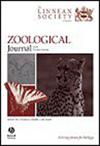螃蟹蜘蛛(Araneae: Thomisidae)食蛛和食蚁习性的进化
IF 3
2区 生物学
Q1 ZOOLOGY
引用次数: 0
摘要
蜘蛛和蚂蚁是蜘蛛食物中不常见的猎物类型。在绒蛛类(蟹)中发现了吃蜘蛛和蚂蚁的习性,但它们的起源仍不清楚。我们的目标是收集绒螯蜘蛛食蛛和食蚁习性的数据,构建一个科级系统发育,并估计这些习性的进化时间。通过猎物接受实验,我们发现了 21 个食蛛属和 18 个食蚁属;根据照片证据,发现了 14 个食蛛属和 20 个食蚁属;根据文献,发现了 6 个食蛛属和 7 个食蚁属。我们总共发现了 28 个食蛛属和 30 个食蚁属。我们使用 75 个标称属的代表物对食蚁兽科进行了迄今为止最广泛的分子系统学分析。分析得出的拓扑结构与之前的研究结果一致:结果表明,匙吻鲟科(Thomisidae)是单系的;Borboropactus属被确定为其余匙吻鲟科的姊妹群;目前的亚科是副系或多系的,Aphantochilinae是单系的,并使Strophiinae成为 "匙吻鲟支系 "中的副系。祖先状态重建估计了食蜘蛛和食蚂蚁的祖先状态,这表明汤蜂科的共同祖先是食蚁性掠食者,不仅以蜘蛛为食,也以蚂蚁为食。本文章由计算机程序翻译,如有差异,请以英文原文为准。
Evolution of spider- and ant-eating habits in crab spiders (Araneae: Thomisidae)
Spiders and ants are infrequent types of prey in the diet of spiders. Both spider- and ant-eating were found in thomisid (crab) spiders but their origin remains unclear. Our goal was to gather data on spider- and ant-eating habits in thomisid spiders, construct a family-level phylogeny, and estimate when these habits evolved. Using prey acceptance experiments, we found 21 spider- and 18 ant-eating genera; based on photographic evidence there were 14 spider- and 20 ant-eating genera; and based on literature there were six spider- and seven ant-eating genera. Altogether we found evidence for 28 spider- and 30 ant-eating genera. We performed the most extensive molecular phylogenetic analysis of Thomisidae to date, using representatives of 75 nominal genera. The resulting topology was congruent with previous studies: Thomisidae were shown to be monophyletic; the genus Borboropactus was identified as a sister group to the remaining thomisids; the current subfamilies emerged as para- or polyphyletic, and Aphantochilinae was monophyletic and rendered Strophiinae paraphyletic within the ‘Thomisus clade’. Ancestral state reconstruction estimated both spider- and ant-eating as ancestral states, suggesting that common ancestors of Thomisidae were euryphagous predators that included spiders but also ants in their diet.
求助全文
通过发布文献求助,成功后即可免费获取论文全文。
去求助
来源期刊
CiteScore
6.50
自引率
10.70%
发文量
116
审稿时长
6-12 weeks
期刊介绍:
The Zoological Journal of the Linnean Society publishes papers on systematic and evolutionary zoology and comparative, functional and other studies where relevant to these areas. Studies of extinct as well as living animals are included. Reviews are also published; these may be invited by the Editorial Board, but uninvited reviews may also be considered. The Zoological Journal also has a wide circulation amongst zoologists and although narrowly specialized papers are not excluded, potential authors should bear that readership in mind.

 求助内容:
求助内容: 应助结果提醒方式:
应助结果提醒方式:


